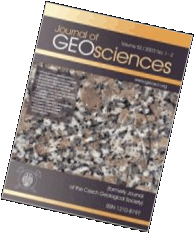 Export to Mendeley
Export to MendeleyOriginal Paper
The modular structure of the novel uranyl sulfate sheet in [Co(H2O)6]3[(UO2)5(SO4)8(H2O)](H2O)5
Journal of Geosciences, volume 59 (2014), issue 2, 135 - 143
DOI: http://doi.org/10.3190/jgeosci.164
A new uranyl sulfate, [Co(H2O)6]3[(UO2)5(SO4)8(H2O)](H2O)5, has been synthesized using mild hydrothermal methods. The structure (monoclinic, P21/c, a = 27.1597(14), b = 9.9858(5), c = 22.7803(12) Å, β = 106.520(1)°, V = 5923.2(5) Å3, Z = 4) has been solved by direct methods and refined on the basis of F2 for all unique reflections to R1 = 0.056, calculated for the 9124 unique observed reflections (|Fo| ≤ 4σF). It contains five symmetrically distinct uranyl pentagonal bipyramids and eight sulfate tetrahedra that link via the sharing of vertices between uranyl polyhedra and sulfate tetrahedra, resulting in sheets parallel to (001). Adjacent sheets are linked by hydrogen bonds to Co2+(H2O)6 octahedra and H2O groups located in the interlayer. The uranyl sulfate sheet contains four- and five-connected uranyl pentagonal bipyramids and three and four-connected sulfate tetrahedra. The sheet may be constructed using modules from related structures involving pentagonal bipyramids and tetrahedra, and is readily described using a nodal representation. In general, the uranyl sulfate sheets in [Co(H2O)6]3[(UO2)5(SO4)8(H2O)](H2O)5 are more rigid than the structural units typically found in comparable uranyl molybdates, which involve the sharing of vertices between uranyl pentagonal bipyramids and molybdate tetrahedra.
Webdesign inspired by aTeo. Hosted at the server of the Institute of Petrology and Structural Geology, Charles University, Prague.
ISSN: 1803-1943 (online), 1802-6222 (print)
email: jgeosci(at)jgeosci.org


IF (WoS, 2024): 1.3
5 YEAR IF (WoS, 2024): 1.4
Policy: Open Access
ISSN: 1802-6222
E-ISSN: 1803-1943